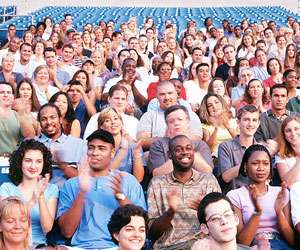Visual 'gist' helps us figure out where a crowd is looking

Have you ever seen a crowd of people looking off into the distance, perhaps toward a passing biker or up to the top of a building? There's a good chance you looked there, too, instantly, even without paying attention to the individuals in the group. How can we tell where a crowd is looking with so little effort?
Researchers at the University of California, Berkeley and the University of Denver have discovered that we rely on a specialized visual process known as "ensemble coding" to perceive where a crowd is looking. Their new study shows that we are able to tell where a group of people is looking, even after just a fraction of a second, by perceiving the group as a single entity rather than a collection of individuals.
This is a photo of a crowd.The findings are published in Psychological Science, a journal of the Association for Psychological Science.
"We see the group as an entity, the same way we see an entire tree without paying attention to the individual leaves," says psychology researcher Timothy Sweeny of the University of Denver. "This highlights the importance of group behavior in human experience – perceiving groups is so important that we have, in fact, evolved dedicated brain processes to perceive them."
Understanding where a group is looking can reveal useful, even vital, information to the viewer; previous research demonstrated that we are actually more responsive to the gaze of a crowd than the gaze of a single person.
"Imagine sitting in the stands at a baseball game. Out of the blue, a dozen people shift their gaze upward, right above your head. Your reaction to this information—is a foul ball headed your way?—will be different than if just one person looked over your head," Sweeny explains.
Sweeny and colleague David Whitney of the University of California, Berkeley wanted to investigate the mechanisms that contribute to this particular form of visual perception. Study participants viewed crowds of computer-generated faces. Sometimes they viewed a full crowd of 4 faces and sometimes they only viewed a subset of 1-3 faces selected from a full crowd. Importantly, the gaze of each of the 16 computer-generated faces was unique.
After viewing a crowd for only one-fifth of a second, participants were asked to estimate where the group was looking, on average, by moving the pupils on a blank face using the right and left arrows on a keyboard. If ensemble coding was at work, Sweeny and Whitney hypothesized, participants' gaze estimates should be better when more information (i.e., more faces) is available.
The data showed that participants' gaze estimates for groups incorporated information from multiple gazes in the crowd, in support of the researchers' hypothesis.
"Even though there wasn't enough time to inspect the individuals, the participants were still able to see the gist of what the entire crowd was doing, as a group," says Sweeny.
According to the researchers, the results indicate that we have a built-in mechanism that allows us to perceive crowd gaze incredibly quickly, and with little effort.
"These findings suggest that many of our complex social behaviors are actually rooted in basic visual processing," says Sweeny.
Sweeny and Whitney believe the findings could elucidate various group-related behaviors, such as panic and rioting, and might, in the future, also shed light on mechanisms that contribute to social deficits in autism spectrum disorders (ASD):
"Exploring how social group perception may or may not be impaired could provide insights into how basic visual deficits might underlie issues of broader social functioning in ASD, which often include disruptions in the perception of global aspects of scenes and perception of eye gaze," Sweeny speculates.
More information: Psychological Science, pss.sagepub.com/content/early/ … 97614544510.abstract

















